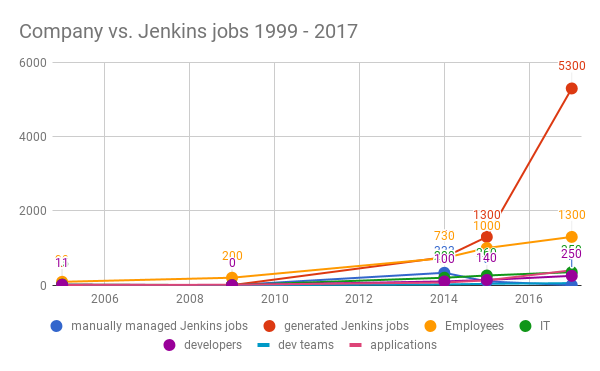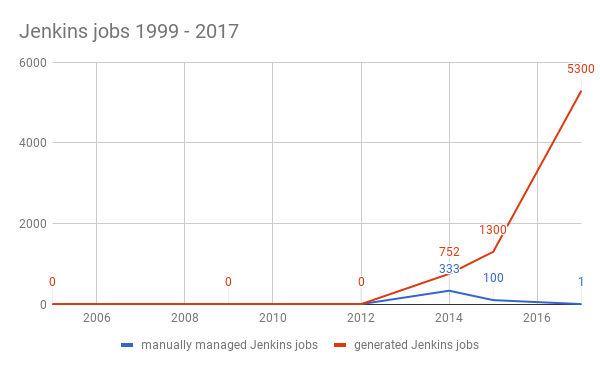Developers in Control
Patrick van Dissel
DPI
Development Process Innovation team
aka Build Tools Automation team
since 2012
~6 engineers
fully autonomous
TAXP

Demo
Features for users
Self-service within a limited framework
Choice between different maturity levels
Support different pipelines types
(eg. app, db, api)
Man on the Moon
Man on the Moon: Phase 1
Every code push is auto deployed to test environment
Build and publish production patch fixes from
patches/*branchesTeam asks SRT to deploy to production
Man on the Moon: Phase 2
same as phase 1, except:
Team can deploy to production themselves
Man on the Moon: Phase 3
same as phase 2, except:
minus the patch production jobs
master == production
Jenkins @ bol.com

Jenkins @ bol.com

Jenkins @ bol.com
~5300 Jenkins jobs
1 master: VM, 6 cores, 47 GB ram
800 GB disk used for jobs8 build slaves: VM, 4 cores, 12 GB ram
~120 GB disk used for builds (per slave)1 build slave: metal, 24 cores, 64 GB ram
~30 GB disk used for builds159 browser test slaves: VM, 1 cores, 4GB ram
~20 GB disk used for builds (per slave)
More info
Users wanted
More freedom
More autonomy
Smaller releases
Releasing more often
But not everyone was ready
Demo
Principles
Feature Centric Development
Isolated runtime environment
Develop(ment)
Test
Accept(ance)
Environment = Production + Feature
Deploy to Production 'when it’s done'
Features for users
Almost fully self-service
Git repository manager (Stash)
Continuous Integration (Jenkins with JobDSL)
Isolated feature environments
Issue tracking (Jira)
Definition of Done checks
Mayfly @ bol.com
#1 team used Mayfly before DPI did
We develop Mayfly with Mayfly
25% of the projects developed with Mayfly
48 of 70+ teams develop with Mayfly
3 mesos masters metal, 8 core, 30 GB ram, HA
3 mesos slaves metal, 24 core, 256 GB ram, HA
More info
You build it, you run it, you love it
Fully Autonomous Teams
A service is owned by a team
A team owns one or more services
Integrations are done with a service account
work in progress
Continuous Delivery
Demo
Features for users
Fully self-service
Git repository manager
Continuous Integration
Isolated feature environments
(environment per branch/MR)Issue tracking, issue boards, milestones, …
Wiki, static-site hosting, …
Gitlab @ bol.com
~100 GB of repositories
3,719 repositories (1,335 forks)
15,196 merge-requests
2 app instances VM, 4 cores, 20 GB ram, HA
2 db instances VM, 4 cores, 6 GB ram, HA
2 redis instances VM, 2 cores, 4 GB ram, HA
3 sentinel instances VM, 2 cores, 4 GB ram, HA
2 runner instances VM, 2 cores, 12 GB ram
What about deployments?
Continuous Deployment
Demo
Features for users
Fully self-service
CI Integrations
(Jenkins, Travis CI, git, cron, docker registry, ..)Deployment Strategies
(red/black, rolling red/black, canary, custom)Monitoring Integrations
Manual Judgments
Role-based Access Control
Spinnaker @ bol.com
Running in Kubernetes
Deploying to Kubernetes
Focus on container based deployments
Artifact Management
What we want
Users should be able to
Manage their own service account
Claim a package namespace for their service (eg. com.bol.myservice)
Add remote repositories to be proxied
Which should be approved by security
Features for users
Fully self-service
hopefully future Artifactory version will support this out-of-the-box,
else we will write a layer around Artifactory
Artifactory @ bol.com
Since ~2012
~10.2 TB of artifacts
Of which 10.1 TB are deployables
756,833 artifacts
Maven, npm, bower, PyPI, gems
2 app instances VM, 4 cores, 16 GB ram, HF
2 db instances VM, 4 cores, 6 GB ram, HA
Code Quality
Users should be able to
Manage their own service account
Dashboards, Rules, Quality Profiles, Quality Gates
Be able to use SonarLint against all projects
Features for users
Fully self-service
hopefully sonarqube 6+ will support this out-of-the-box, else we will implement it into sonarqube, or we will write a layer around sonarqube
sonarqube @ bol.com
Since ~2015
~200 projects
1 app instance VM, 4 cores, 8 GB ram
2 db instances VM, 2 cores, 8 GB ram, HA
Build Support
Build Support
Build Support
Build Automation consultants
Best practices
Templates
Plugins
Resources
Thanks
Slides & code
ikoodi.nl/talks
github.com/pvdissel/talks
Want to help? banen.bol.com